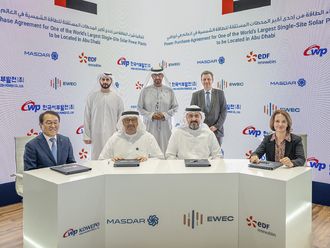London: Siemens AG and Gamesa Corp Tecnologica SA agreed to combine their wind-turbine manufacturing businesses, creating a company with the biggest installed capacity worldwide in a move that speeds consolidation of the industry.
Europe’s largest engineering company will own 59 per cent of the capital of the new business, Gamesa said in a statement on its website Friday. Gamesa, based in Zamudio, Spain, gets 41 per cent and a €1 billion (Dh4.1 billion, $1.1 billion) cash payment of €3.75 a share from Siemens. That represents a 26 per cent premium on Gamesa’s share price on January 28 before the two disclosed their negotiations.
Together, the two would have about 69 gigawatts of turbines installed worldwide, leading Vestas Wind Systems A/S and General Electric Co. While worldwide clean-energy installations have hit successive records in recent years, a boom in manufacturing capacity and improvements in the technology have narrowed margins for making the machines. Companies are having to compete on a global scale, with Xinjiang Goldwind Science & Technology Co. of China taking the biggest market share last year.
“The combination of our wind business with Gamesa follows a clear and compelling industrial logic in an attractive growth industry, in which scale is a key to making renewable energy more cost-effective,” Siemens Chief Executive Officer Joe Kaeser said in a statement.
Shares jump
Gamesa shares jumped as much as 5.6 per cent in Madrid. Siemens were up 0.3 per cent in Frankfurt trading. Vestas rose as much as 5.6 per cent in Copenhagen to its highest price since Jan. 10.
Gamesa Chairman Ignacio Martin said the move would boost earnings and have positive cash flows from its inception. “We will continue to work as before, albeit as part of a stronger company and with an enhanced ability to offer all of our customers end-to-end solutions,” he said in a statement.
The two have identified cost savings of 230 million euros that will be made within the next four years as a result of the deal. The combined company will have an order backlog of €20 billion, annual revenue of €9.3 billion and earnings before interest and taxes of €839 million. It will be based and listed in Spain, though the headquarters of the offshore-wind unit will be in Hamburg and Vejle, Denmark.
Each of the companies had about 5.3 per cent of the global wind turbine market last year, according to Bloomberg New Energy Finance data. There combined 10.6 per cent share would rank the new entity third behind Goldwind and Vestas.
Gamesa’s network of installed turbines is attractive to Siemens, which has been trying to expand revenue from service contracts. The German company leads in machines designed for use offshore, while Gamesa specialises in onshore wind.
Europe’s turbine makers already have been consolidating. Last month, Nordex SE of Germany completed the purchase of the turbine-manufacturing assets of Acciona SA, another Spanish wind company. Vestas fired thousands of workers and closed factories to revive its profit after price pressures led to three years of losses that ended in 2014.
Deal’s structure
The Spanish utility Iberdrola SA currently holds 20 per cent of Gamesa and will have 8 per cent of the combined company. The transaction is expected to be completed in the first quarter of 2017.
Areva SA has a venture with Gamesa called Adwen that’s developing an offshore-wind turbine and has contracts to build seven wind farms off the French and German coastlines. Gamesa said Areva waved its contractual restrictions to allow the deal to progress and will receive options to buy or sell its stake in the venture over the next three months.
“We basically see a new kid on the block arriving to the offshore scene,” said Keegan Kruger, a wind analyst at Bloomberg New Energy Finance. “Siemens faces stiff competition from GE and from MHI Vestas,” which is a joint venture in offshore wind owned by Vestas and Mitsubishi Heavy Industries Ltd of Japan.
For Siemens, the wind division is the smallest of its eight operational businesses, and also has the lowest profitability target.
Perfect partner
The Spanish and German companies also complement each other in the markets they serve. Gamesa is strong in South America and India as well as being the biggest foreign supplier in China. Europe, the Middle East, Africa and North America meanwhile account for almost 90 per cent of Siemens’s customer base, according to BNEF.
“As a leading wind power player especially in emerging markets, Gamesa is a perfect partner for us,” said Lisa Davis, member of the managing board of Siemens. “Teaming up will enable Siemens and Gamesa to offer a much broader range of products. The move will put Siemens and Gamesa in the best position to shape the industry for lower cost of renewable energy to the consumers.”












